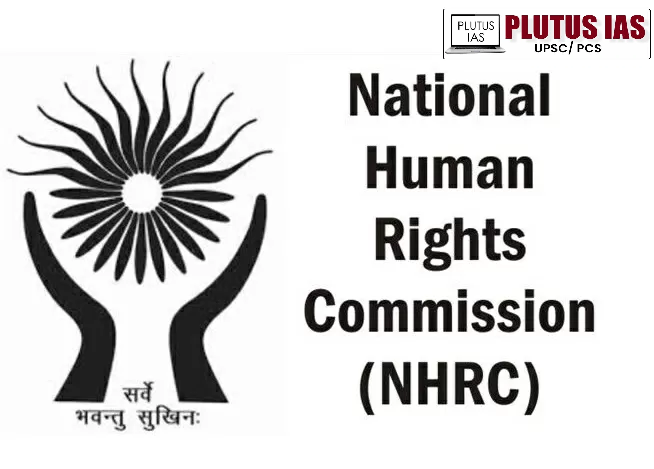24 Dec NHRC: A Pillar of Justice and Human Rights in India
SYLLABUS MAPPING:
GS-2-Polity and Governance- Constitutional on constitutional bodies: NHRC
FOR PRELIMS:
NHRC power and functions, compositions and facts related to NRHC Act 1993
FOR MAINS
What are the major achievements of NHRC, its limitations of NHRC and how can NHRC be more effective
Why in the news?
What is NHRC?

NHRC Act 1993:
The Protection of Human Rights Act of 1993 established the National Human Rights Commission (NHRC) in India.
1. Establishment of the NHRC: The NHRC is headed by a Chairperson, usually a former Chief Justice of India, and includes other members with expertise in human rights.
2. Functions and Powers: The NHRC investigates human rights violations, makes recommendations to the government, and can intervene in legal proceedings. It also monitors laws and practices to ensure human rights standards are met.
3. State Human Rights Commissions: The Act allows for the creation of State Human Rights Commissions to handle regional cases.
4. Human Rights Education: It promotes human rights awareness and protects human rights defenders.
5. Annual Reports: The NHRC is required to submit an annual report to the President of India detailing its activities and the state of human rights in the country. This helps in ensuring transparency and accountability in its functioning.
Composition of NHRC:
1. Chairperson: The Chairperson is a retired Chief Justice of India or a retired Supreme Court Judge. The appointment is made by the President of India.
2. Members:
One member must be a person who has been a judge of the Supreme Court of India or is a distinguished jurist.
Two members must be persons who have been the Chief Justices of High Courts.
One member should be a person with experience in the field of human rights, and ideally, this person should have a background in social work, law, or any related field. The President also appoints these members.
3. Selection Committee:
The selection of the Chairperson and members is done by a committee comprising:
The Prime Minister (Chairperson of the committee)
The Home Minister
The Leader of the Opposition in the Lok Sabha
The Speaker of the Lok Sabha
The Leader of the Opposition in the Rajya Sabha
NHRC-Powers and functions:
| Category | Powers | Functions |
|---|---|---|
| Investigative | – Can take serious action on human rights violations. | – Investigates human rights violations and seeks redress for victims. |
| Power to Intervene | – Can intervene in legal proceedings related to human rights in courts. | – Provides advice to the government on human rights policies and laws. |
| Recommendations | – Can recommend actions to the government, including reforms and compensation for victims. | – Promotes awareness of human rights through education and campaigns. |
| Inspection | – Can visit places of detention (jails, mental hospitals) to ensure rights protection. | – Coordinates with State Human Rights Commissions for effective protection. |
| Call for Records | – Can demand records from government bodies for review. | – Submits annual reports to the President on investigations and actions. |
| Seek Information | – Can request information from authorities for inquiries. | – Ensures follow-up on its recommendations and monitors government action. |
| Advisory Role | – Provides recommendations to improve human rights protections. | – Educates authorities and the public on human rights issues. |
NHRC achievements in the last three decades:
1. Awareness and Advocacy: Raised public awareness through workshops, seminars, and campaigns on human rights, reaching millions. Advocated for human rights education in schools, training 25,000 teachers and 5,000 law enforcement officials.
2. Investigation and Redressal: Investigated thousands of violations, including police brutality and custodial deaths. Helped secure compensation for victims of rights violations, including ₹15 lakh for custodial death cases in 2018.
3. Strengthening Laws and Policies: Influenced revisions to the Child Labour Act and Protection of Women from Domestic Violence Act. Advocated for legislative reforms on torture, human trafficking, and child rights.
4. Protection of Vulnerable Groups: Focused on women’s, Dalit, tribal, and refugee rights. For example, helped 1,000+ victims of sexual harassment and trafficking. Led campaigns on gender violence and displacement issues, benefiting marginalized communities.
5. Prison and Detention Reforms: Inspected jails and exposed overcrowded conditions, leading to improved prison reforms. Reduced overcrowding by 20% in prisons through NHRC’s intervention.
6. Reporting and Accountability: Submits annual reports to the President, urging quicker action on pending complaints. Ensures 70% of recommendations are implemented, promoting government accountability.
7. Landmark Case Interventions: Intervened in key PILs like Narmada Bachao Andolan and custodial deaths, leading to legal reforms. Filed petitions to ensure police reforms and anti-discrimination laws.
8. International Cooperation and Recognition: Collaborated with organizations like Amnesty International and Human Rights Watch on forced labour and human trafficking. Recognized by the UN for its proactive role in human rights advocacy and children’s rights.
limitations of NHRC:
1. Limited Jurisdiction: NHRC cannot investigate events that occurred more than one year ago. Limited jurisdiction over armed forces and private parties involved in human rights violations.
2. Non-Binding Recommendations: NHRC’s recommendations are not legally binding on the government or other bodies.
3. Inability to Penalize: NHRC cannot punish authorities that fail to implement its recommendations or orders.
4. Administrative Constraints: Faces resource shortages, including insufficient funding and staffing challenges, affecting its effectiveness.
5. Lack of Diversity: Criticized for the lack of diversity in its composition, as the Chairman and members are mainly from the judicial fraternity.
6. Lack of Independence: NHRC’s composition depends on government appointments, which raises concerns about its independence.
7. Reactive Response: NHRC often acts reactively to complaints rather than proactively addressing systemic human rights issues.
Way forward:
1. Expanding Jurisdiction: Advocate for an expansion of its jurisdiction to include more cases, particularly those involving the armed forces and private parties. It should also be empowered to investigate events that happened beyond one year.
2. Strengthening Recommendations: The NHRC should work towards making its recommendations legally binding, ensuring greater accountability in the implementation of its suggestions.
3. Resource Allocation: Increase funding and staff to overcome administrative challenges and enhance its investigative capacity, making it more proactive.
4. Promoting Diversity: Ensure greater diversity in the commission’s composition by including experts from various backgrounds like social work, law, and human rights, and not limiting the membership primarily to judicial figures.
5. Ensuring Independence: Strengthen the independence of the NHRC by ensuring its leadership and members are free from political influence, perhaps by adopting a more transparent and independent selection process.
6. Proactive Approach: Shift from a reactive approach to a more proactive stance by monitoring human rights conditions more closely and initiating investigations into systemic issues without waiting for complaints.
Conclusion
Q. Which of the following statements regarding the National Human Rights Commission (NHRC) of India are correct?
1. The NHRC is empowered to take binding legal actions against the government.
2. The NHRC’s recommendations are legally binding on the government and other authorities.
3. NHRC investigates complaints of human rights violations and can intervene in legal proceedings.
4. The NHRC is mandated to submit annual reports to the President of India.
Choose the correct answer using the code below:
A. 1, 2, and 3
B. 3 and 4
C. 1, 3, and 4
D. 2 and 4
Answer: B
Mains Question:
Q. The National Human Rights Commission (NHRC) has played an instrumental role in safeguarding human rights in India over the past three decades. Discuss these limitations and suggest measures to enhance the NHRC’s capacity to protect human rights more effectively.
(250 words, 15 marks)




No Comments